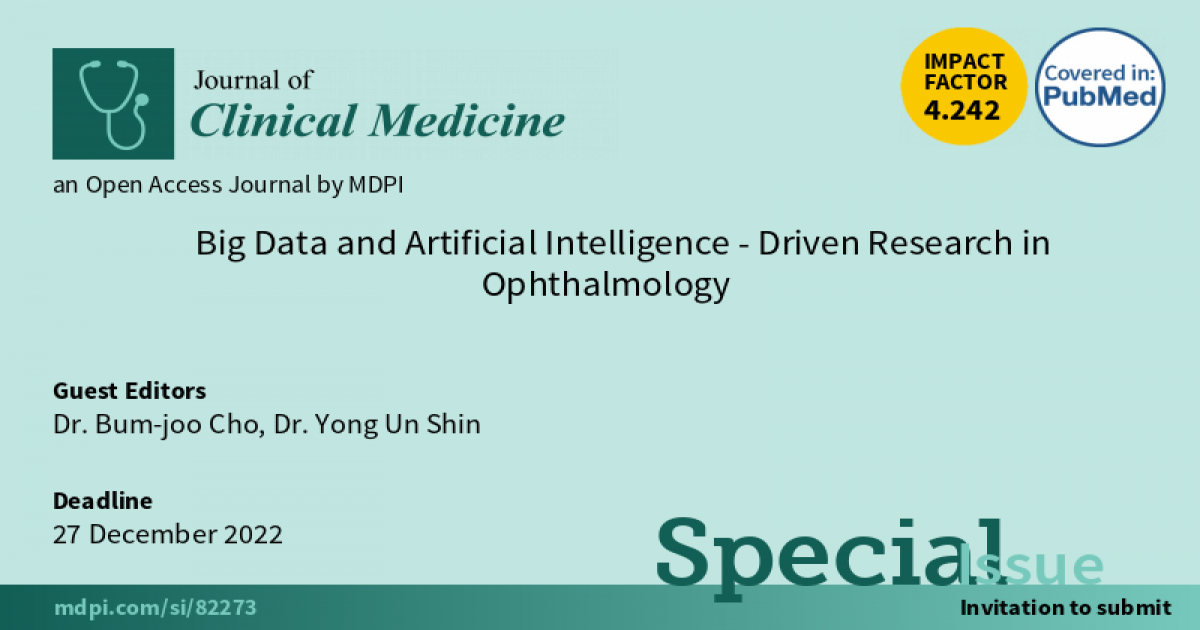Big Data and Artificial Intelligence-Driven Research in Ophthalmology
A special issue of Journal of Clinical Medicine (ISSN 2077-0383). This special issue belongs to the section "Ophthalmology".
Deadline for manuscript submissions: closed (27 December 2022) | Viewed by 21430

Special Issue Editors
2. Medical Artificial Intelligence Center, Hallym University Medical Center, Anyang 14068, Korea
3. Division of Biomedical Informatics, Seoul National University Biomedical Informatics (SNUBI), Seoul National University College of Medicine, Seoul 03080, Korea
Interests: machine learning; retina; uveitis; diabetic retinopathy; age-related macular degeneration; convolutional neural network
Special Issue Information
Dear Colleagues,
In recent years, medical big data such as national health examination survey data, health insurance claim data, genome analysis data, or medical image data are being collected, and the size of data is increasing rapidly. Additionally, artificial intelligence (AI), which learns and makes decisions by computers based on data, has been introduced in various fields of medicine thanks to the improvement of computing power and mathematical algorithms. Big data and artificial intelligence are the key concepts of the 4th industrial revolution.
In ophthalmology, since the cornerstone study on the development of deep learning algorithm of fundus photographs for diabetic retinopathy in 2016, much research adopting AI for diagnosis or prognosis prediction of the diseases is actively being published. Also, a lot of studies using big data have validated several previously presented hypotheses in the general population.
Research using big data and AI has enabled automated disease screening, diagnosis or risk prediction, and strong power of verification on subtle topics, as well as a discovery of new knowledge by computer. Although it is obvious that there are still some challenges that big data analysis and machine learning technology need to overcome, these data-driven research designs are very crucial in future studies in ophthalmology. We want to activate big data and AI-driven researches in ophthalmology and become a stepping stone for the future.
This Special Issue of the Journal of Clinical Medicine will cover the following important aspects of big data and artificial intelligence-driven research in ophthalmology.
- Big data-based epidemiology of ophthalmologic diseases:
prevalence, incidence, risk factors, odds ratio, relative risk, survival, etc.
- Any big data analysis using a large database in ophthalmology:
national health and nutrition examination survey, health insurance claim database, routine health checkup data, electronic medical records, genomic data, or medical image data
- AI research on medical images using deep learning such as convolutional neural network or generative adversarial network in ophthalmology
- AI research on non-image data such as numeric, text, bio-signal, or genomic data using any type of machine learning algorithm in ophthalmology
- Clinical applications of AI or machine learning technologies or systems in ophthalmology
- Data extraction, manipulation, pre-processing, or curation technologies in ophthalmology
We look forward to receiving your submissions.
Dr. Bum-joo Cho
Dr. Yong Un Shin
Guest Editors
Manuscript Submission Information
Manuscripts should be submitted online at www.mdpi.com by registering and logging in to this website. Once you are registered, click here to go to the submission form. Manuscripts can be submitted until the deadline. All submissions that pass pre-check are peer-reviewed. Accepted papers will be published continuously in the journal (as soon as accepted) and will be listed together on the special issue website. Research articles, review articles as well as short communications are invited. For planned papers, a title and short abstract (about 100 words) can be sent to the Editorial Office for announcement on this website.
Submitted manuscripts should not have been published previously, nor be under consideration for publication elsewhere (except conference proceedings papers). All manuscripts are thoroughly refereed through a single-blind peer-review process. A guide for authors and other relevant information for submission of manuscripts is available on the Instructions for Authors page. Journal of Clinical Medicine is an international peer-reviewed open access semimonthly journal published by MDPI.
Please visit the Instructions for Authors page before submitting a manuscript. The Article Processing Charge (APC) for publication in this open access journal is 2600 CHF (Swiss Francs). Submitted papers should be well formatted and use good English. Authors may use MDPI's English editing service prior to publication or during author revisions.
Keywords
- big data
- population study
- artificial intelligence
- deep learning
- machine learning
- convolutional neural network
- precision medicine






